Research Trends in the Use of the Internet of Things in Sustainability Practices: A Systematic Review
Abstract
1. Introduction
2. Materials and Methods
2.1. Eligibility Criteria
2.2. Information Sources
2.3. Search Strategy
- For the Web of Science database: (TI = (“internet of things” OR “IoT” OR “smart devices” OR “connected devices” OR “smart objects”) AND TI = (sustainability OR sustainable));
- For the Scopus database: (TITLE (“internet of things” OR “IoT” OR “smart devices” OR “connected devices” OR “smart objects”) AND TITLE (sustainability OR sustainable)).
2.4. Data Management
2.5. Selection Process
2.6. PRISMA Registration Number
3. Results
4. Discussion
5. Practical Implications
6. Limitations
7. Conclusions
Supplementary Materials
Funding
Institutional Review Board Statement
Informed Consent Statement
Data Availability Statement
Acknowledgments
Conflicts of Interest
Abbreviations
| Abbreviation | Meaning |
| IoT | Internet of Things |
| PRISMA | Preferred Reporting Items for Systematic Reviews and Meta-Analyses |
| AI | Artificial intelligence |
| UAVs | Unmanned aerial vehicles |
| WPCN | Wireless communication network |
| PCE | Power conversion efficiency |
| SCM | Supply chain management |
| ICT | Information and communication technology |
References
- Khaniabadi, S.M.; Javadpour, A.; Gheisari, M.; Zhang, W.; Liu, Y.; Sangaiah, A.K. An intelligent sustainable efficient transmission internet protocol to switch between User Datagram Protocol and Transmission Control Protocol in IoT computing. Expert Syst. 2023, 40, e13129. [Google Scholar] [CrossRef]
- Priyanka, B.H.D.D.; Udayaraju, P.; Koppireddy, C.S.; Neethika, A. Developing a region-based energy-efficient IoT agriculture network using region- based clustering and shortest path routing for making sustainable agriculture environment. Meas. Sens. 2023, 27, 100734. [Google Scholar] [CrossRef]
- Bibri, S.E.; Alexandre, A.; Sharifi, A.; Krogstie, J. Environmentally sustainable smart cities and their converging AI, IoT, and big data technologies and solutions: An integrated approach to an extensive literature review. Energy Inform. 2023, 6, 9. [Google Scholar] [CrossRef] [PubMed]
- Scandurra, G.; Arena, A.; Ciofi, C. A Brief Review on Flexible Electronics for IoT: Solutions for Sustainability and New Perspectives for Designers. Sensors 2023, 23, 5264. [Google Scholar] [CrossRef] [PubMed]
- Zovko, K.; Šerić, L.; Perković, T.; Belani, H.; Šolić, P. IoT and health monitoring wearable devices as enabling technologies for sustainable enhancement of life quality in smart environments. J. Clean. Prod. 2023, 413, 137506. [Google Scholar] [CrossRef]
- Dosumu, O.S.; Uwayo, S.M. Modelling the adoption of Internet of things (IoT) for sustainable construction in a developing economy. Built Environ. Proj. Asset Manag. 2023, 13, 394–411. [Google Scholar] [CrossRef]
- Guzman, B.G.; Talavante, J.; Fonseca, D.F.; Mir, M.S.; Giustiniano, D.; Obraczka, K.; Loik, M.E.; Childress, S.; Wong, D.G. Toward Sustainable Greenhouses Using Battery-Free LiFi-Enabled Internet of Things. IEEE Commun. Mag. 2023, 61, 129–135. [Google Scholar] [CrossRef]
- Pecunia, V.; Occhipinti, L.G.; Hoye, R.L.Z. Emerging Indoor Photovoltaic Technologies for Sustainable Internet of Things. Adv. Energy Mater. 2021, 11, 2100698. [Google Scholar] [CrossRef]
- Alsamhi, S.H.; Afghah, F.; Sahal, R.; Hawbani, A.; Al-Qaness, M.A.; Lee, B.; Guizani, M. Green internet of things using UAVs in B5G networks: A review of applications and strategies. Ad Hoc Netw. 2021, 117, 102505. [Google Scholar] [CrossRef]
- Maqbool, R.; Saiba, M.R.; Ashfaq, S. Emerging industry 4.0 and Internet of Things (IoT) technologies in the Ghanaian construction industry: Sustainability, implementation challenges, and benefits. Environ. Sci. Pollut. Res. 2023, 30, 37076–37091. [Google Scholar] [CrossRef]
- Qi, Q.; Xu, Z.; Rani, P. Big data analytics challenges to implementing the intelligent Industrial Internet of Things (IIoT) systems in sustainable manufacturing operations. Technol. Forecast. Soc. Chang. 2023, 190, 122401. [Google Scholar] [CrossRef]
- Nižetić, S.; Šolić, P.; González-de-Artaza, D.L.-d.I.; Patrono, L. Internet of Things (IoT): Opportunities, issues and challenges towards a smart and sustainable future. J. Clean. Prod. 2020, 274, 122877. [Google Scholar] [CrossRef] [PubMed]
- Reyana, A.; Kautish, S.; Alnowibet, K.A.; Zawbaa, H.M.; Mohamed, A.W. Opportunities of IoT in Fog Computing for High Fault Tolerance and Sustainable Energy Optimization. Sustainability 2023, 15, 8702. [Google Scholar] [CrossRef]
- Mao, S.; Liu, L.; Shao, C. Energy-efficient scheduling for active RIS-assisted self-sustainable wireless powered IoT networks in smart societies. Sustain. Cities Soc. 2023, 95, 104559. [Google Scholar] [CrossRef]
- Morchid, A.; El Alami, R.; Raezah, A.A.; Sabbar, Y. Applications of internet of things (IoT) and sensors technology to increase food security and agricultural Sustainability: Benefits and challenges. Ain Shams Eng. J. 2023, 15, 102509. [Google Scholar] [CrossRef]
- Wang, W.-C.; Dwijendra, N.K.A.; Sayed, B.T.; Alvarez, J.R.N.; Al-Bahrani, M.; Alviz-Meza, A.; Cárdenas-Escrocia, Y. Internet of Things Energy Consumption Optimization in Buildings: A Step toward Sustainability. Sustainability 2023, 15, 6475. [Google Scholar] [CrossRef]
- Pour, F.L.; Ha, D.S. Effect of Power Conversion Efficiency of the RF Energy Harvester on the Security and Data Rate of the Self-Sustainable IoT Devices. In Proceedings of the European Interdisciplinary Cybersecurity Conference, Stavanger, Norway, 14–15 June 2023; pp. 121–124. [Google Scholar] [CrossRef]
- Al Duhayyim, M. Modified Cuttlefish Swarm Optimization with Machine Learning-Based Sustainable Application of Solid Waste Management in IoT. Sustainability 2023, 15, 7321. [Google Scholar] [CrossRef]
- Page, M.J.; E McKenzie, J.; Bossuyt, P.M.; Boutron, I.; Hoffmann, T.C.; Mulrow, C.D.; Shamseer, L.; Tetzlaff, J.M.; A Akl, E.; E Brennan, S.; et al. The PRISMA 2020 statement: An updated guideline for reporting systematic reviews. Int. J. Surg. 2021, 88, 105906. [Google Scholar] [CrossRef]
- Martín-Martín, A.; Thelwall, M.; Orduna-Malea, E.; López-Cózar, E.D. Google Scholar, Microsoft Academic, Scopus, Dimensions, Web of Science, and OpenCitations’ COCI: A multidisciplinary comparison of coverage via citations. Scientometrics 2021, 126, 871–906. [Google Scholar] [CrossRef]
- Orduña-Malea, E.; Costas, R. Link-based approach to study scientific software usage: The case of VOSviewer. Scientometrics 2021, 126, 8153–8186. [Google Scholar] [CrossRef]
- Ahmed, I.; Zhang, Y.; Jeon, G.; Lin, W.; Khosravi, M.R.; Qi, L. A blockchain- and artificial intelligence-enabled smart IoT framework for sustainable city. Int. J. Intell. Syst. 2022, 37, 6493–6507. [Google Scholar] [CrossRef]
- Tham, P.E.; Ng, Y.J.; Vadivelu, N.; Lim, H.R.; Khoo, K.S.; Chew, K.W.; Show, P.L. Sustainable smart photobioreactor for continuous cultivation of microalgae embedded with Internet of Things. Bioresour. Technol. 2022, 346, 126558. [Google Scholar] [CrossRef]
- De Villiers, C.; Kuruppu, S.; Dissanayake, D. A (new) role for business—Promoting the United Nations’ Sustainable Development Goals through the internet-of-things and blockchain technology. J. Bus. Res. 2021, 131, 598–609. [Google Scholar] [CrossRef]
- Islam, N.; Rashid, M.; Pasandideh, F.; Ray, B.; Moore, S.; Kadel, R. A review of applications and communication technologies for IoT and unmanned aerial vehicle (uav) based sustainable smart farming. Sustainability 2021, 13, 1821. [Google Scholar] [CrossRef]
- Singh, S.; Sharma, P.K.; Yoon, B.; Shojafar, M.; Cho, G.H.; Ra, I.-H. Convergence of blockchain and artificial intelligence in IoT network for the sustainable smart city. Sustain. Cities Soc. 2020, 63, 102364. [Google Scholar] [CrossRef]
- Abou-Nassar, E.M.; Iliyasu, A.M.; El-Kafrawy, P.M.; Song, O.-Y.; Bashir, A.K.; Abd El-Latif, A.A. DITrust chain: Towards blockchain-based trust models for sustainable healthcare IoT systems. IEEE Access 2020, 8, 111223–111238. [Google Scholar] [CrossRef]
- Jamshidi, M.; Yahya, S.I.; Nouri, L.; Hashemi-Dezaki, H.; Rezaei, A.; Chaudhary, M.A. A Super-Efficient GSM Triplexer for 5G-Enabled IoT in Sustainable Smart Grid Edge Computing and the Metaverse. Sensors 2023, 23, 3775. [Google Scholar] [CrossRef] [PubMed]
- Ali, J.; Khan, M.F. A Trust-Based Secure Parking Allocation for IoT-Enabled Sustainable Smart Cities. Sustainability 2023, 15, 6916. [Google Scholar] [CrossRef]
- Lăzăroiu, G.; Harrison, A. Internet of things sensing infrastructures and data-driven planning technologies in smart sustainable city governance and management. Geopolit. Hist. Int. Relat. 2021, 13, 23–36. [Google Scholar]
- Lazaroiu, G.; Androniceanu, A.; Grecu, I.; Grecu, G.; Neguriță, O. Artificial intelligence-based decision-making algorithms, Internet of Things sensing networks, and sustainable cyber-physical management systems in big data-driven cognitive manufacturing. Oeconomia Copernic. 2022, 13, 1047–1080. [Google Scholar] [CrossRef]
- Manavalan, E.; Jayakrishna, K. A review of Internet of Things (IoT) embedded sustainable supply chain for industry 4.0 requirements. Comput. Ind. Eng. 2019, 127, 925–953. [Google Scholar] [CrossRef]
- Bibri, S.E. The IoT for smart sustainable cities of the future: An analytical framework for sensor-based big data applications for environmental sustainability. Sustain. Cities Soc. 2018, 38, 230–253. [Google Scholar] [CrossRef]
- Williams, A.; Suler, P.; Vrbka, J. Business process optimization, cognitive decision-making algorithms, and artificial intelligence data-driven internet of things systems in sustainable smart manufacturing. J. Self-Gov. Manag. Econ. 2020, 8, 39–48. [Google Scholar]
- Riley, C.; Vrbka, J.; Rowland, Z. Internet of things-enabled sustainability, big data-driven decision-making processes, and digitized mass production in industry 4.0-based manufacturing systems. J. Self-Gov. Manag. Econ. 2021, 9, 42–52. [Google Scholar]
- Haseeb, K.; Din, I.U.; Almogren, A.; Ahmed, I.; Guizani, M. Intelligent and secure edge-enabled computing model for sustainable cities using green internet of things. Sustain. Cities Soc. 2021, 68, 102779. [Google Scholar] [CrossRef]
- Islam, N.; Altamimi, M.; Haseeb, K.; Siraj, M. Secure and sustainable predictive framework for IoT-based multimedia services using machine learning. Sustainability 2021, 13, 13128. [Google Scholar] [CrossRef]
- Jin, X.-B.; Yu, X.-H.; Wang, X.-Y.; Bai, Y.-T.; Su, T.-L.; Kong, J.-L. Deep learning predictor for sustainable precision agriculture based on internet of things system. Sustainability 2020, 12, 1433. [Google Scholar] [CrossRef]
- Kovacova, M.; Lewis, E. Smart factory performance, cognitive automation, and industrial big data analytics in sustainable manufacturing internet of things. J. Self-Gov. Manag. Econ. 2021, 9, 9–21. [Google Scholar]
- Majumdar, S.; Subhani, M.M.; Roullier, B.; Anjum, A.; Zhu, R. Congestion prediction for smart sustainable cities using IoT and machine learning approaches. Sustain. Cities Soc. 2021, 64, 102500. [Google Scholar] [CrossRef]
- Lyons, N.; Lăzăroiu, G. Addressing the COVID-19 crisis by harnessing Internet of Things sensors and machine learning algorithms in data-driven smart sustainable cities. Geopolit. Hist. Int. Relat. 2020, 12, 65–71. [Google Scholar]
- Scott, R.; Poliak, M.; Vrbka, J.; Nica, E. COVID-19 response and recovery in smart sustainable city governance and management: Data-driven Internet of Things systems and machine learning-based analytics. Geopolit. Hist. Int. Relat. 2020, 12, 16–22. [Google Scholar]
- Yadav, S.; Luthra, S.; Garg, D. Modelling Internet of things (IoT)-driven global sustainability in multi-tier agri-food supply chain under natural epidemic outbreaks. Environ. Sci. Pollut. Res. 2021, 28, 16633–16654. [Google Scholar] [CrossRef]
- Zhang, Q.; Li, L.; Wang, T.; Jiang, Y.; Tian, Y.; Jin, T.; Yue, T.; Lee, C. Self-sustainable flow-velocity detection via electromagnetic/triboelectric hybrid generator aiming at IoT-based environment monitoring. Nano Energy 2021, 90, 106501. [Google Scholar] [CrossRef]
- Zhao, J.; Zheng, X.; Dong, R.; Shao, G. The planning, construction, and management toward sustainable cities in China needs the Environmental Internet of Things. Int. J. Sustain. Dev. World Ecol. 2013, 20, 195–198. [Google Scholar] [CrossRef]
- Belli, L.; Cilfone, A.; Davoli, L.; Ferrari, G.; Adorni, P.; Di Nocera, F.; Dall’olio, A.; Pellegrini, C.; Mordacci, M.; Bertolotti, E. IoT-enabled smart sustainable cities: Challenges and approaches. Smart Cities 2020, 3, 1039–1071. [Google Scholar] [CrossRef]
- Bibri, S.E.; Bibri, S.E. The IoT and Big Data Analytics for Smart Sustainable Cities: Enabling Technologies and Practical Applications. In Advances in the Leading Paradigms of Urbanism and Their Amalgamation: Compact Cities, Eco–Cities, and Data–Driven Smart Cities; Springer: Cham, Switzerland, 2020; pp. 191–226. [Google Scholar] [CrossRef]
- Anand, P.; Singh, Y.; Selwal, A.; Alazab, M.; Tanwar, S.; Kumar, N. IoT vulnerability assessment for sustainable computing: Threats, current solutions, and open challenges. IEEE Access 2020, 8, 168825–168853. [Google Scholar] [CrossRef]
- Nica, E.; Stan, C.I.; Luțan, A.G.; Oașa, R.Ș. Internet of things-based real-time production logistics, sustainable industrial value creation, and artificial intelligence-driven big data analytics in cyber-physical smart manufacturing systems. Econ. Manag. Financ. Mark. 2021, 16, 52–63. [Google Scholar]
- Peoples, C.; Parr, G.; McClean, S.; Scotney, B.; Morrow, P. Performance evaluation of green data centre management supporting sustainable growth of the internet of things. Simul. Model. Pract. Theory 2013, 34, 221–242. [Google Scholar] [CrossRef]
- Kidd, P. The role of the internet of things in enabling sustainable agriculture in Europe. Int. J. RF Technol. Res. Appl. 2012, 3, 67–83. [Google Scholar] [CrossRef]
- Kim, H.; Kang, J. Dynamic Group Management Scheme for Sustainable and Secure Information Sensing in IoT. Sustainability 2016, 8, 1081. [Google Scholar] [CrossRef]
- Maksimovic, M. The Role of Green Internet of Things (G-IoT) and Big Data in Making Cities Smarter, Safer and More Sustainable. Int. J. Comput. Digit. Syst. 2017, 6, 175–184. [Google Scholar] [CrossRef]
- Stergiou, C.; Psannis, K.E.; Gupta, B.B.; Ishibashi, Y. Security, privacy & efficiency of sustainable Cloud Computing for Big Data & IoT. Sustain. Comput. Inform. Syst. 2018, 19, 174–184. [Google Scholar] [CrossRef]
- Banu, F.J.; Revathi, R.; Suganya, M.; Gladiss-Merlin, N.R. IoT based Cloud Integrated Smart Classroom for smart and a sustainable Campus. Procedia Comput. Sci. 2020, 172, 77–81. [Google Scholar] [CrossRef]
- Sodhro, A.H.; Pirbhulal, S.; Luo, Z.; de Albuquerque, V.H.C. Towards an optimal resource management for IoT based Green and sustainable smart cities. J. Clean. Prod. 2019, 220, 1167–1179. [Google Scholar] [CrossRef]
- Alyami, S.H.; Alreshidi, E.J. Holistic IoT Architecture for Smart Sustainable Cities Current Perspective and Future Directions. In Proceedings of the 2019 6th International Conference on Computing for Sustainable Global Development (INDIACom), New Delhi, India, 13–15 March 2020; pp. 312–317. Available online: https://ieeexplore.ieee.org/abstract/document/8991274/authors#authors (accessed on 21 January 2024).
- Hamm, A. Particles Matter: A Case Study on How Civic IoT Can Contribute to Sustainable Communities. In Proceedings of the 7th International Conference on ICT for Sustainability, Bristol, UK, 21–26 June 2020; pp. 305–313. [Google Scholar] [CrossRef]
- Zahmatkesh, H.; Al-Turjman, F. Fog computing for sustainable smart cities in the IoT era: Caching techniques and enabling technologies—An overview. Sustain. Cities Soc. 2020, 59, 102139. [Google Scholar] [CrossRef]
- Wolfert, S.; Isakhanyan, G. Sustainable agriculture by the Internet of Things—A practitioner’s approach to monitor sustainability progress. Comput. Electron. Agric. 2022, 200, 107226. [Google Scholar] [CrossRef]
- Wongchai, A.; Shukla, S.K.; Ahmed, M.A.; Sakthi, U.; Jagdish, M.; Kumar, R. Artificial intelligence—Enabled soft sensor and internet of things for sustainable agriculture using ensemble deep learning architecture. Comput. Electr. Eng. 2022, 102, 108128. [Google Scholar] [CrossRef]
- Albreem, M.A.; Sheikh, A.M.; Bashir, M.J.K.; El-Saleh, A.A. Towards green Internet of Things (IoT) for a sustainable future in Gulf Cooperation Council countries: Current practices, challenges and future prospective. Wirel. Netw. 2023, 29, 539–567. [Google Scholar] [CrossRef]
- Eynolghozat, M.; Ziyae, B.; Rezvani, M. IoT-based entrepreneurial city: A new model of urban governance to achieve economic sustainability. Kybernetes 2023. [Google Scholar] [CrossRef]
- Safari, A.; Kharrati, H. Application of Optical Wireless Communications in IoT Devices of Smart Grids within Smart Sustainable Cities: With Hybrid Perspectives to Metaverse & Quantum IoT. In Proceedings of the 2023 8th International Conference on Technology and Energy Management (ICTEM), Babol, Iran, 8–9 February 2023; pp. 1–7. [Google Scholar] [CrossRef]
- Kamruzzaman, M.M.; Alanazi, S.; Alruwaili, M.; Alshammari, N.; Elaiwat, S.; Abu-Zanona, M.; Innab, N.; Elzaghmouri, B.M.; Alanazi, B.A. AI- and IoT-Assisted Sustainable Education Systems during Pandemics, such as COVID-19, for Smart Cities. Sustainability 2023, 15, 8354. [Google Scholar] [CrossRef]
- Prabakar, D.; Sundarrajan, M.; Manikandan, R.; Jhanjhi, N.Z.; Masud, M.; Alqhatani, A. Energy Analysis-Based Cyber Attack Detection by IoT with Artificial Intelligence in a Sustainable Smart City. Sustainability 2023, 15, 6031. [Google Scholar] [CrossRef]
- Saba, T.; Rehman, A.; Haseeb, K.; Bahaj, S.A.; Damaševičius, R. Sustainable Data-Driven Secured Optimization Using Dynamic Programming for Green Internet of Things. Sensors 2022, 22, 7876. [Google Scholar] [CrossRef]
- Dhanaraju, M.; Chenniappan, P.; Ramalingam, K.; Pazhanivelan, S.; Kaliaperumal, R. Smart Farming: Internet of Things (IoT)-Based Sustainable Agriculture. Agriculture 2022, 12, 1745. [Google Scholar] [CrossRef]
- Lim, H.R.; Khoo, K.S.; Chia, W.Y.; Chew, K.W.; Ho, S.-H.; Show, P.L. Smart microalgae farming with internet-of-things for sustainable agriculture. Biotechnol. Adv. 2022, 57, 107931. [Google Scholar] [CrossRef] [PubMed]
- Rai, A.; Singh, R.P.; Jain, N. Role of IoT in Sustainable Healthcare Systems. In Ambient Intelligence and Internet of Things; Wiley: Hoboken, NJ, USA, 2022; pp. 215–241. [Google Scholar] [CrossRef]
- Badawy, M. Sustainable Secure Internet of Things (SS-IoT). In Proceedings of the 2023 1st International Conference on Advanced Innovations in Smart Cities (ICAISC), Jeddah, Saudi Arabia, 23–25 January 2023; pp. 1–6. [Google Scholar] [CrossRef]
- Zhang, C.; Xu, Y.; Elahi, H.; Zhang, D.; Tan, Y.; Chen, J.; Zhang, Y. A Blockchain-Based Model Migration Approach for Secure and Sustainable Federated Learning in IoT Systems. IEEE Internet Things J. 2023, 10, 6574–6585. [Google Scholar] [CrossRef]
- Goswami, V.; Sharma, B.; Patra, S.S.; Chowdhury, S.; Barik, R.K.; Ben Dhaou, I. IoT-Fog Computing Sustainable System for Smart Cities: A Queueing-based Approach. In Proceedings of the 2023 1st International Conference on Advanced Innovations in Smart Cities (ICAISC), Jeddah, Saudi Arabia, 23–25 January 2023; pp. 1–6. [Google Scholar] [CrossRef]
- Islam, M.M.; Khan, Z.; Alsaawy, Y. A framework for harmonizing internet of things (IoT) in cloud: Analyses and implementation. Wirel. Netw. 2021, 27, 4331–4342. [Google Scholar] [CrossRef]
- She, R.; Sun, M. Security Energy Efficiency Analysis of CR-NOMA Enabled IoT Systems for Edge-cloud Environment. Int. J. Comput. Intell. Syst. 2023, 16, 118. [Google Scholar] [CrossRef]
- Albouq, S.S.; Sen, A.A.A.; Almashf, N.; Yamin, M.; Alshanqiti, A.; Bahbouh, N.M. A survey of interoperability challenges and solutions for dealing with them in IoT environment. IEEE Access 2022, 10, 36416–36428. [Google Scholar] [CrossRef]
- Aljrees, T.; Kumar, A.; Singh, K.U.; Singh, T. Enhancing IoT Security through a Green and Sustainable Federated Learning Platform: Leveraging Efficient Encryption and the Quondam Signature Algorithm. Sensors 2023, 23, 8090. [Google Scholar] [CrossRef]
- Nalajala, P.; Gudikandhula, K.; Shailaja, K.; Tigadi, A.; Rao, S.M.; Vijayan, D. Adopting internet of things for manufacturing firms business model development. J. High Technol. Manag. Res. 2023, 34, 100456. [Google Scholar] [CrossRef]
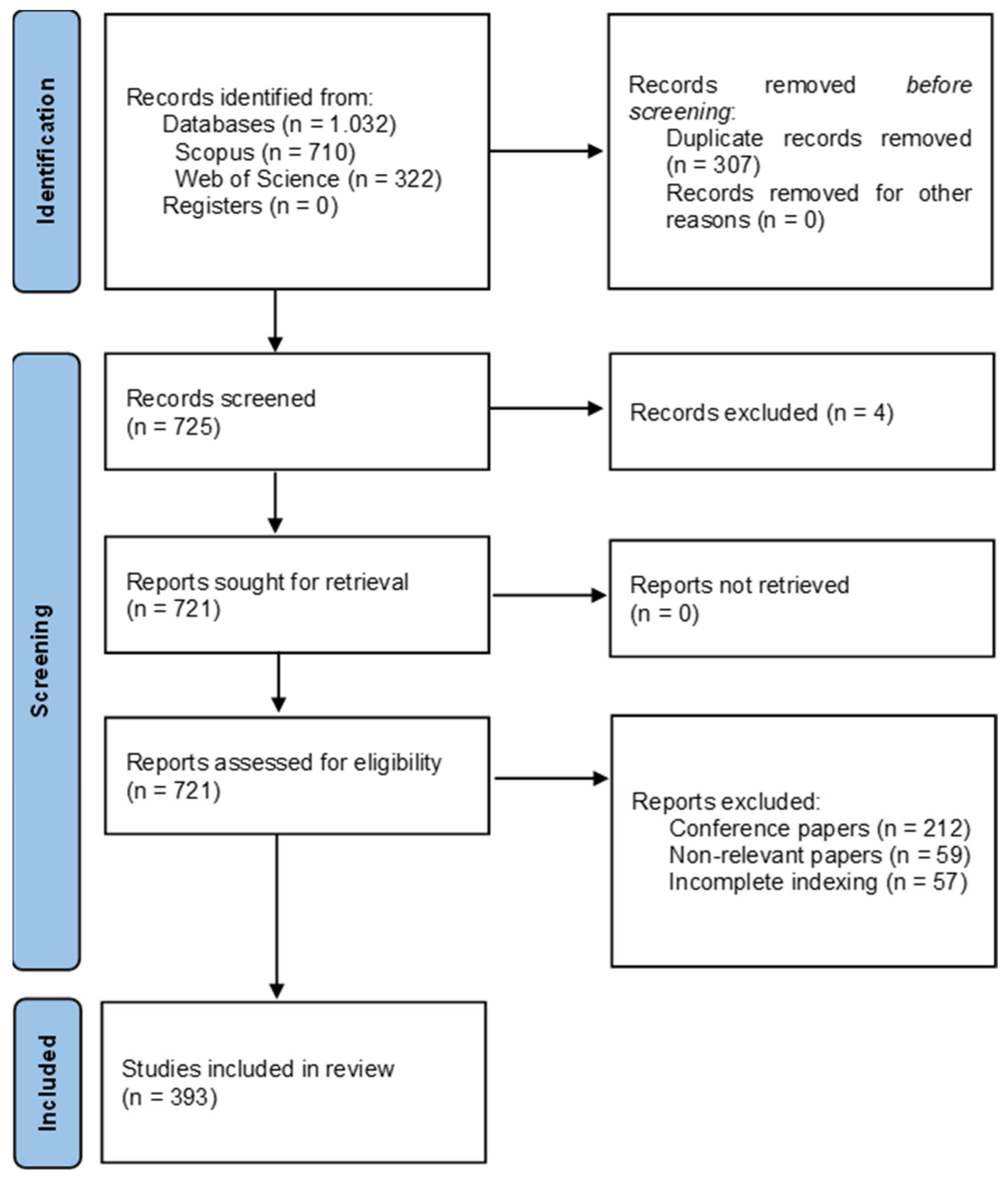
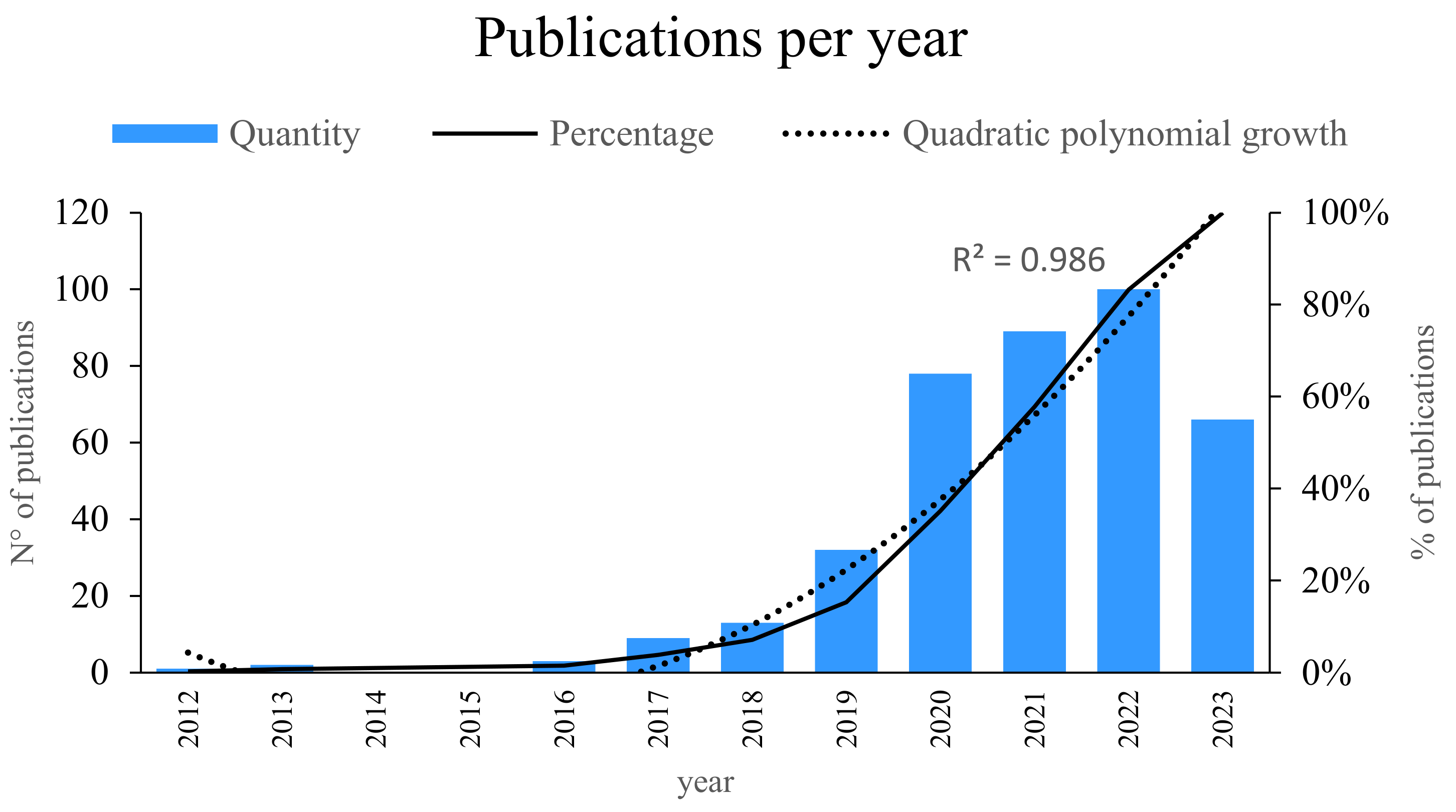


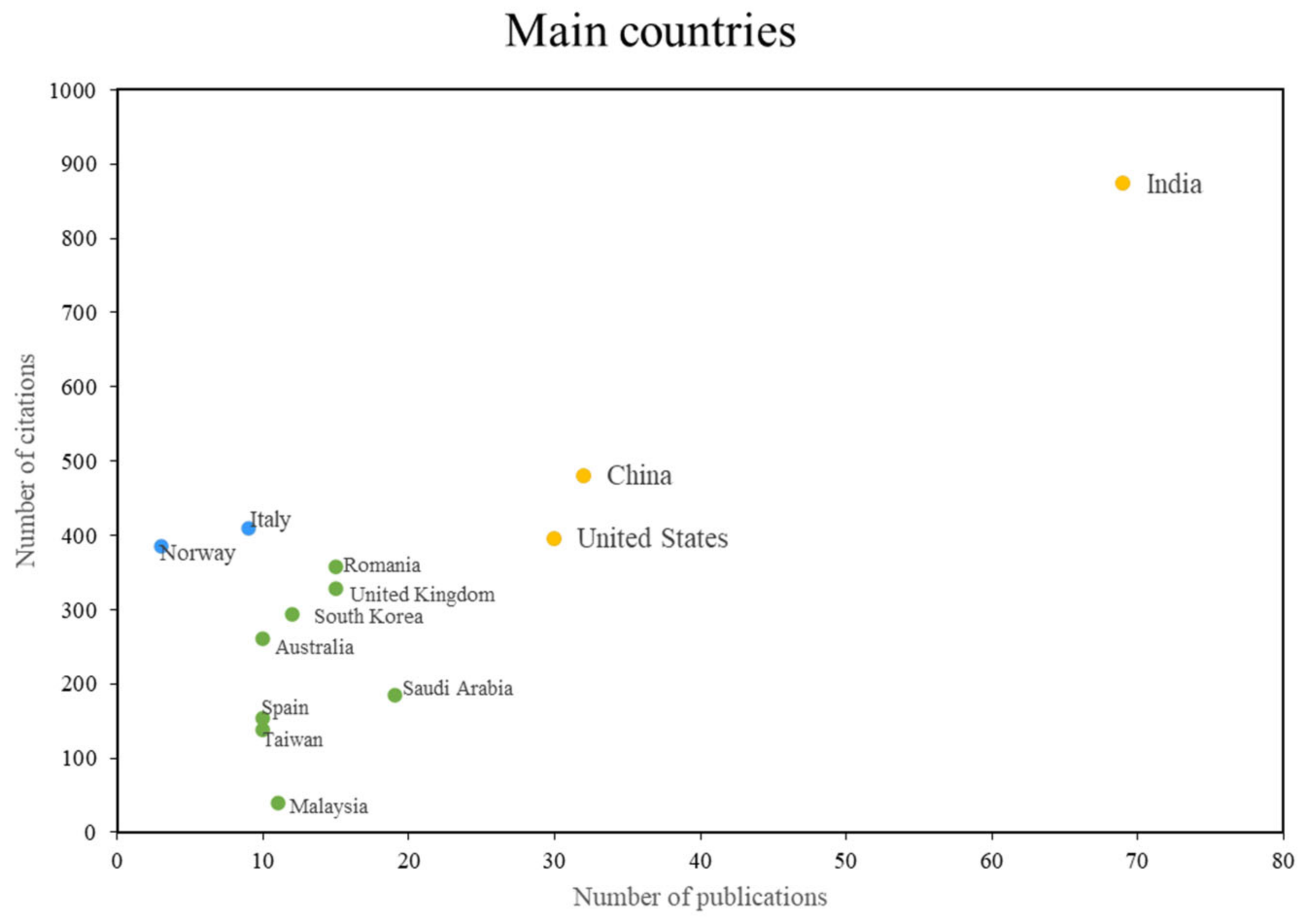
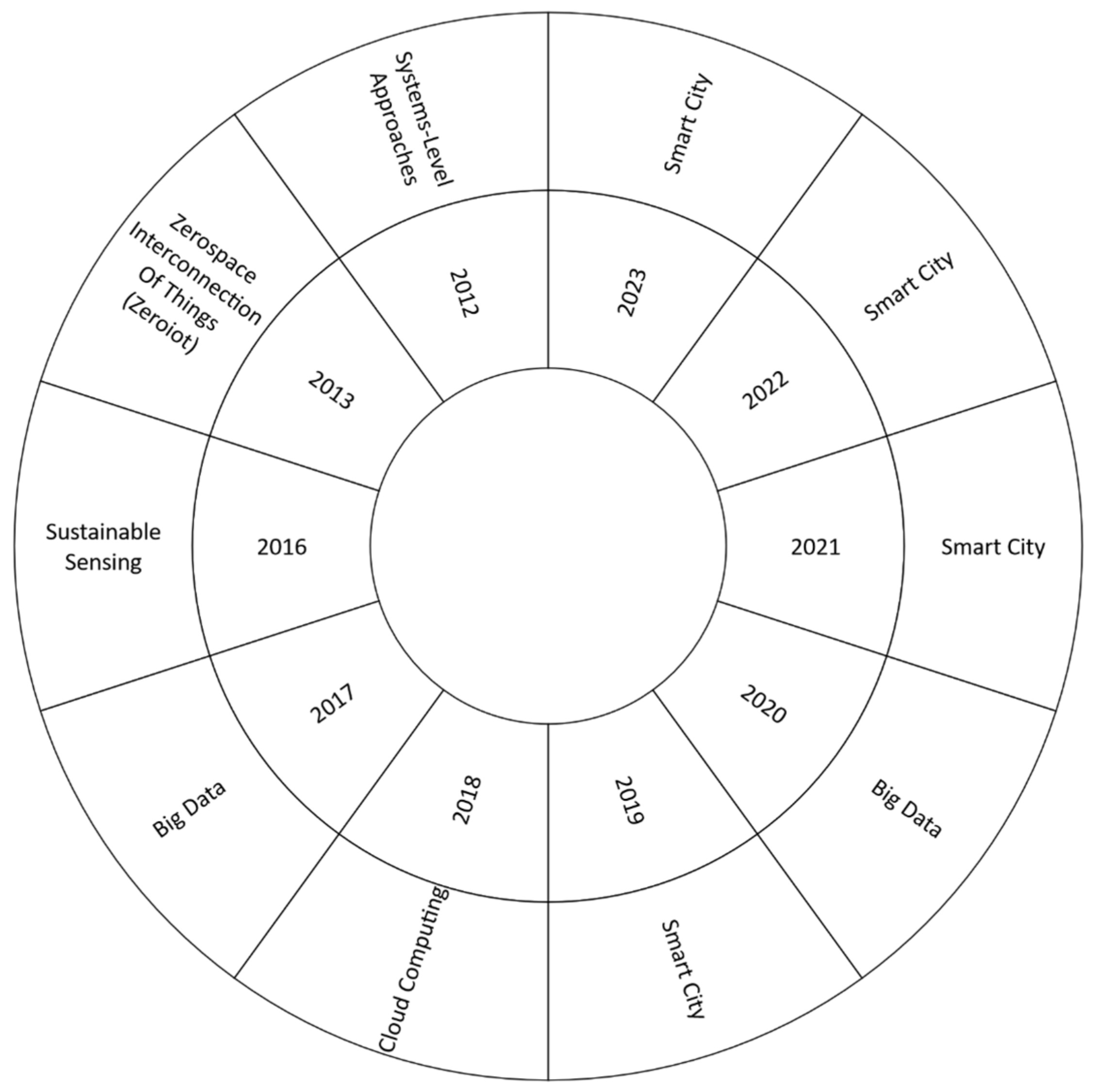
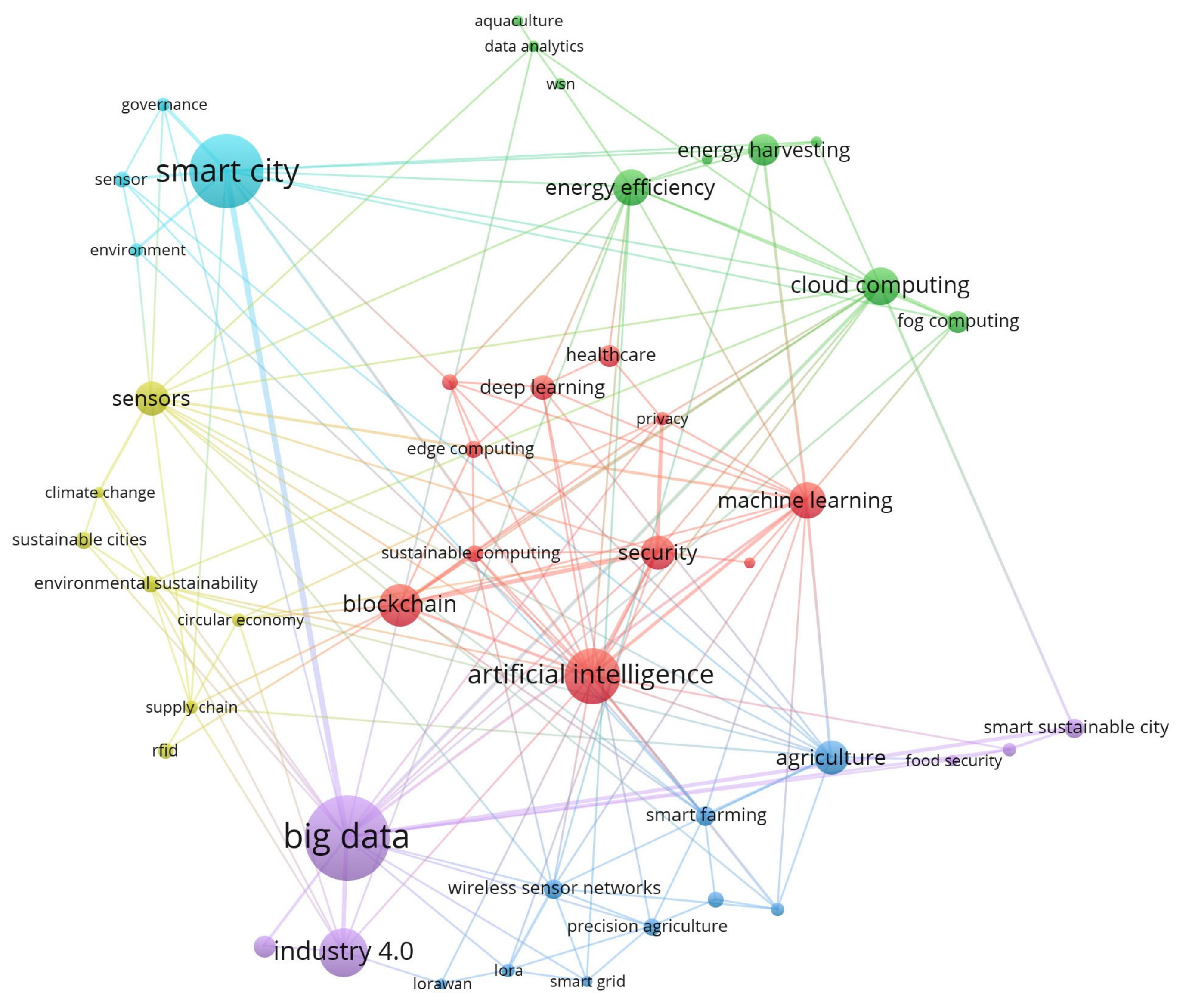


Disclaimer/Publisher’s Note: The statements, opinions and data contained in all publications are solely those of the individual author(s) and contributor(s) and not of MDPI and/or the editor(s). MDPI and/or the editor(s) disclaim responsibility for any injury to people or property resulting from any ideas, methods, instructions or products referred to in the content. |
© 2024 by the authors. Licensee MDPI, Basel, Switzerland. This article is an open access article distributed under the terms and conditions of the Creative Commons Attribution (CC BY) license (https://creativecommons.org/licenses/by/4.0/).
Share and Cite
Valencia-Arias, A.; Ramírez Dávila, J.; Londoño-Celis, W.; Palacios-Moya, L.; Hernández, J.L.; Agudelo-Ceballos, E.; Uribe-Bedoya, H. Research Trends in the Use of the Internet of Things in Sustainability Practices: A Systematic Review. Sustainability 2024, 16, 2663. https://doi.org/10.3390/su16072663
Valencia-Arias A, Ramírez Dávila J, Londoño-Celis W, Palacios-Moya L, Hernández JL, Agudelo-Ceballos E, Uribe-Bedoya H. Research Trends in the Use of the Internet of Things in Sustainability Practices: A Systematic Review. Sustainability. 2024; 16(7):2663. https://doi.org/10.3390/su16072663
Chicago/Turabian StyleValencia-Arias, Alejandro, Juana Ramírez Dávila, Wilmer Londoño-Celis, Lucia Palacios-Moya, Julio Leyrer Hernández, Erica Agudelo-Ceballos, and Hernán Uribe-Bedoya. 2024. "Research Trends in the Use of the Internet of Things in Sustainability Practices: A Systematic Review" Sustainability 16, no. 7: 2663. https://doi.org/10.3390/su16072663
APA StyleValencia-Arias, A., Ramírez Dávila, J., Londoño-Celis, W., Palacios-Moya, L., Hernández, J. L., Agudelo-Ceballos, E., & Uribe-Bedoya, H. (2024). Research Trends in the Use of the Internet of Things in Sustainability Practices: A Systematic Review. Sustainability, 16(7), 2663. https://doi.org/10.3390/su16072663







